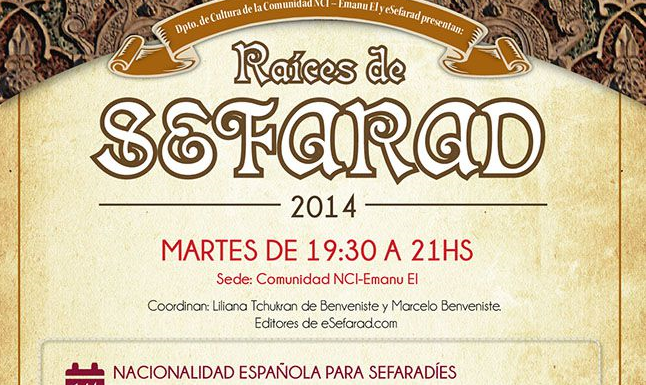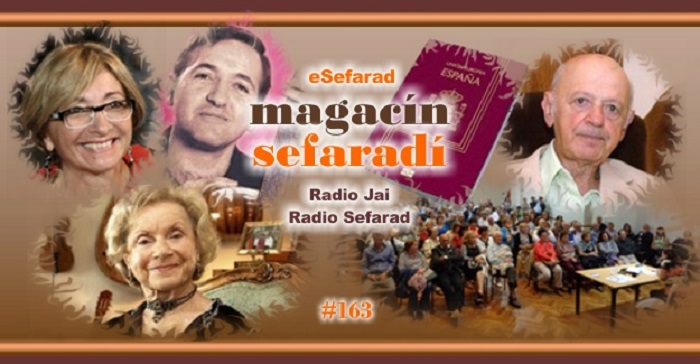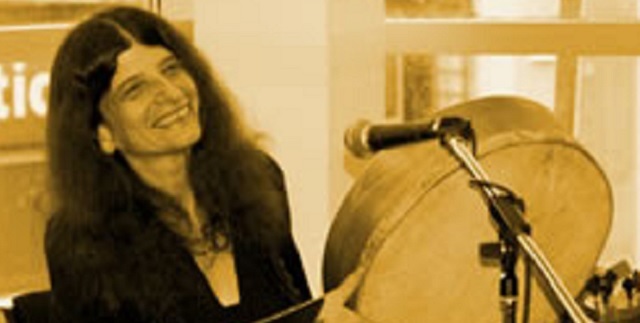EMPEZAR QUIERO CONTAR, CON JUDITH COHEN – En la anterior entrega hablamos del romancero sefardí. Hoy lo haremos de las canciones del ciclo de la vida. La mayoría de estas son las de la boda – pero no todas: hay para el parto, el nacimiento, etc. Hay que admitir que se celebraba más el nacimiento de un hijo – un fizhiko – que una hija – una fizhika -, por lo menos en las canciones. En un cantar de brit milá, de circuncisión de Marruecos, “las que parían los niños, comían los ricos visios”, pero “las que parían las niñas, comían flacas sardinas” y, encima – en buena jaquetía – se les mandan a la “cozzina”, donde “pelean con las vizzina”. En la kantika de parida que vamos a escuchar ahora – muy conocida en Turquía y Grecia- se celebra el nacimiento del hijo varón. La canta David Saltiel, de Salónica.
Tambien se cantaba como canción de alumbramiento la famosa “Cuando el rey Nimrod”, que cuenta el nacimiento de Abraham. Escuchemos una versión menos conocida de la historia, cantada aquí por Berta o Bienvenida Aguado, nacida en Canakkale, Turquía, y que vive desde hace muchos años en Israel.
Se cantaban canciones de cuna, por supuesto, que generalmente eran romances. Y algunas canciones para niños sí que hay. “Chichi bunichi” – chico y bonico – es una rima tradicional para niños pequeños, arreglada por Flory Jagoda, la muy querida “nona” de Bosnia. Cuando mi hija Tamar Ilana era pequeña y tenía 8 años, la grabamos juntas para Radio Canadá – aquí está, de nuestro CD “Dans mon chemin”.
Cuando empezaba la eskola se le recitaba lo siguiente, como me explicó la familia Gomel, de Esmirna, en Montreal hace muchos años:
Había también unas canciones para el joven cuando llegaba a ser bar mitzvá… pero vamos ahora al casamiento. En una boda tradicional, muchas veces los novios no se escogían, sino que los padres lo arreglaban todo. Sin embargo, los jóvenes podían soñar con quien casarse (siempre podemos soñar). Y a principios del siglo XX, las cosas iban cambiando. Esta canción de aquella época se canta en turco y en lenguas eslavas, entre el padre y la hija, pero las mujeres sefarditas de Estambul cambiaron – trokaron – la letra para que fuera un diálogo entre madre e hija. La joven se niega a casarse con el alto, con el bashiko, con el tinyozo… pero acepta al borracho. Como habéis oído ahora a Tamar de pequeña, aquí está unos años más tarde, cuando cantábamos con Wafir Sheikh, Bill Cooley y Eduardo Paniagua, en nuestro disco “Sefarad en Diáspora”.
Antes de celebrar la boda, había muchas etapas preparativas, que no vamos a comentar aquí con mucho detalle. Entre ellas, exponer el ajuar – el ashuar o ashugar – de la novia, para que todos pudieran admirarlo (o criticarlo). Aquí la novia dice a la suegra y a la cuñada “no tengáis que dezir”: la cantábamos en Gerineldo – Solly Levy, Kelly Sultán Amar, nuestra directora Oro Anahory-Librowicz y yo, la “token Ashkenazi” – así.
La casa tenía que estar muy bien preparada para la boda. Aquí Alicia Benassayag, de Tetuán, la describe, grabada por Susana Weich-Shahak en Israel.
Los novios y sus familias intercambiaban regalos. En esta kantika de boda, Mazaltov Lazar y sus compañeras, también grabadas por Susana Weich-Shahak en Israel, cantan con un ritmo muy conocido en los Balcanes y en Turquía, un ritmo de nueve – 1-2, 1-2, 1-2, 1-2-3.
En Sarajevo, en Bosnia, hacían el baile de los parientes, como podemos oír en esta grabación, con Clara Kadmon-Cohen.
Por supuesto, la novia tenía que ir al mikvé, al baño ritual, que en las canciones de boda suele ser llamado “el mar”. Aquí canta Bouena Sarfaty Garfinkle, de Salonica, cuando la grabé en Montreal en los años 80.
Poco antes de la boda en Marruecos era la noche de la novia, o la noche de al-henya, de pintar las manos de la novia con diseños de henna; se le cantaban más y más canciones… La madre de la novia y su futura suegra, la mujer que le había prestado el traje suntuoso de boda, la berberisca, sus amigas, todas visten a la novia y después la vienen a buscar los hombres para acompañarla a la casa del novio. La novia mantiene los ojos cerrados –va guiada por sus padres, en el cortejo con velas, con la familia, con los paytanim que cantaban. Aquí, con Gerineldo, Solly Lévy canta la pedida de la novia, que era siempre seguida por el piyyút “Ya alat’hen”.
Dejaremos aquí a los novios empezar su nueva vida. Para completar el ciclo de la vida faltan las endechas – u oínas -, que, como las canciones de cuna, suelen ser romances – casi cualquier romance triste, y también algunos dedicados al luto. Las endechas se cantaban no solamente para el luto personal o de familia, sino también en los días de luto colectivo, por ejemplo Tishá be-Av, uniendo el ciclo de la vida con el ciclo del año judío. Los sefardíes del norte de Marruecos tienen una tradición singular – cantaban “Don Gato” con la melodía muy conocida en España – pero en Tishá be-Av cantaban la letra con una melodía de qiná, de endecha, los niños sobre todo – pero sin reírse, porque, se decía, si se reía en Tishá be-Av, el día de luto, llorarían en Rosh Hashaná, el día del Año nuevo. Aquí, con Gerineldo, la cantamos en ambas versiones.
Para despedirnos, una canción de boda metafórica – de la ketubá alegórica entre el pueblo de Israel y el Dios – el Dio en judeoespañol. El poema, “Es razón de alabar”, es de Yehudah bar León, de Salonica, del siglo XVIII. Esta versión está cantada por el gran rabino-jazán Isaac Algazi, nacido en Esmirna en 1889 y fallecido en Uruguay en 1950. Esta grabación es de los años 1920. Y con la maestría del rabino Algazi, se acabará esta tercera entrega. En la próxima, escucharemos algunas canciones del ciclo del año judío. Hasta entonces, saludos desde Canadá, a todos los de Radio Sefarad, y a todos vosotros oyentes, de vuestra amiga Judith Cohen.
[TEXT IN ENGLISH:
EMPEZAR QUIERO CONTAR, WITH JUDITH COHEN 3. Songs of the life cycle.
Hi, I’m Judith Cohen, speaking to you from Canada. The last time we were here at Radio Sefarad together, I told you about the romances, the narrative ballads. Today we’ll talk about songs of the life cycle, el ciclo de la vida. The majority of these are wedding songs, and there are also songs for birth, coming of age, and death. Traditions are not always in agreement with current societal norms, and Jewish tradition has tended to celebrate the birth of a male child – un fizhiko – more than that of a female- una fizhika , at least in the old songs. One short Moroccan Sephardic song for the brit milá, the circumcision of a male child at eight days of age, says: “those [women] who bear male children, should eat delectable foods”, but then adds, “and those who bear female babies, eat skinny sardines”, and, to cap it, in good khaketía, Moroccan Judeo-Spanish, “should be banished to the kitchen to squabble with their [woman] neighbour”. In this birth song, a kantika de parida, well-known in Greece and Turkey, we hear a celebration of the birth of a boy, sung by David Saltiel of Salónica.
Another song often sung after the birth of a boy is the well-known ““Cuando el rey Nimrod”, also known by its refrain “Avraham avinu”. Here is an earlier, lesser-known version of this story of Abraham’s birth and growth, sung by Berta or Bienvenida Aguado, born in Çanakkale, Turkey, and who lived much of her life in Bat Yam, near Tel Aviv. My friend and colleague, the illustrious ethnomusicologist Edwin Seroussi, has carried out a detailed study of this emblematic song, which in its most popular form, is much less “ancient” than popularly supposed.
Of course, women sang lullabies, often using romances for this purpose.There are also some children’s songs. Here “Chichi bunichi” – chico y bonico, little and good-looking – a traditional children’s rhyme, arranged by the beloved “nona” (grandmother) of Bosnia, Flory Jagoda. When my daughter Tamar Ilana was only eight years old, we recorded it together in a programme for Radio Canada, later released as a CD, “Dans mon chemin”.
When a child began school, la eskola , the Gomel family of Izmir , the old Smyrna, explained to me, the family sang him (in the old days, it was always a little boy beginning school) the following chant, “La Tora”.
There are a few songs for a boy reaching Bar Mitzva age, but for now let’s go directly to weddings. In weddings in the old days – as in so many cultures – the newly-weds may not have chosen their partners, as their parents arranged the marriage. Still, one can always dream, and many Sephardic songs describe young people’s dreams of their future spouse. By the turn of the 20th century, things were changing. This song from ther early 20th century is found in Turkish and in Slavic languages, as a father-daughter dialogue, but Sephardic women of Istanbul altered– trokaron – it to be a a dialogue between mother and daughter. The daughter rejects the suggested suitors – the tall one, the short one, the one with skin problems,,,, but accepts the “borracho”, the drunkard, or rascal. Since you just heard Tamar singing as a child, here she is singing “No kero, madre”with me as a young adult in 2005, on our CD “Sefarad en Diáspora” with Eduardo Paniagua, Wafir Sheikh and Bill Cooley.
Before the wedding, there were many stages of preparation. Among them was displaying the bride’s trousseau, the ashuar or ashugar , so everyone could admire (and/or criticize) it. In this song, the bride-to-ve says to her future mother-in-law and sister-in-law, “there’s nothing for you to criticize here!” This is an old recording of “Ashuar muevo” we made with Gerineldo – Solly Levy, Kelly Sultán Amar, our founder-director Oro Anahory-Librowicz and myself.
The house had to be well prepared for the wedding, as “Estas casas” relates, sung Alicia Benassayag, of Tetuán, recorded in Israel by another colleague and friend, the indefatigable Susana Weich-Shahak . The bride and groom’s families exchanged gifts – in “Yo le mandi”, Mazaltov Lazar and her friends, also recorded by Susana Weich-Shahak in Israel, use a rhythm which is very well-known in the Balkans and in Turkey, in 9: 2+2+2+3. In Sarajevo, Bosnia-Hercegovina, they danced the in-laws’ dance, sung here by Clara Kadmon-Cohen.
Like any observant Jewish bride, the Sephardic bride had to go to the mikvé, the ritual bath, which in many wedding songs is referred to as “the sea”. Here is Bouena Sarfatty Garfinkle, of Salonica, in a recording I made of her in Montreal, in the early 1980s
In Morocco, before the wedding itself, there was the henna night, “la noche de al-henya”, when the bride’s hands were painted with henna designs, and one song after another was sung. Her mother would be there, her future mother-in-law, perhaps a woman who’d loaned the bride her best wedding robe, traje de berberisca, her friends – they dressed the bride, then went to summon the men to accompany them on the walk to the groom’s home. The bride kept her eyes cast down, with her parents guiding her , holding her elbows on either side, as they walked through narrow streets with candles lighting their way, and the paytanim of the community singing wedding songs in Hebrew. Here, with Gerineldo, Solly Lévy sings the groom’s party’s formal demand to bring out the bride, followed by the piyyút “Ya alat’hen”.
And here we’ll let the newlyweds begin their new life. To complete the songs of the life cycle, one does need to hear some laments – endechas – or oínas – which, like many wedding songs, are often romances. Any narrative ballad with a sad or tragic theme might be used, though there are also specific ones for this purpose. Laments were sung not only for personal losses, but also on days of collective mourning, for example Tisha be’Av, bridging the life cycle and the calendar cycle. The Sephardim of Northern Morocco, the former Spanish Zone, have an unusual tradition: they sing the popular Spanish children’s song, “Sir Cat” (Don Gato) but on Tisha be’Av they use the melody of a qiná, a lament, without laughing at all at the ballad’s story, because, it was said, whoever laughed on Tisha be’Av, the day of mourning, would soon afterwards weep on Rosh HaShanah, the New Year. Here, with Gerineldo, we sing both versions,
We’ll end with a song of a metaphprical wedding, and the allegorical ketubá , wedding contract, between the people of Israel and the Creator. The poem“Es razón de alabar” (“there is reason to praise”) is by Yehudah bar León, of 18th century Salonica. This version is sung by the great rabbi and hazán Isaac Algazi, Izmir 1889-Uruguay 1950. The recording is an early one, from the 1920s. And with the virtuosic singing of Rabbi Algazi, we end this third programme of our series. In the next one, we’ll hear some songs of the Jewish life cycle. Till then, greetings from Canada to everyone at Radio Sefarad and all you listeners, from your friend Judith Cohen. ]




